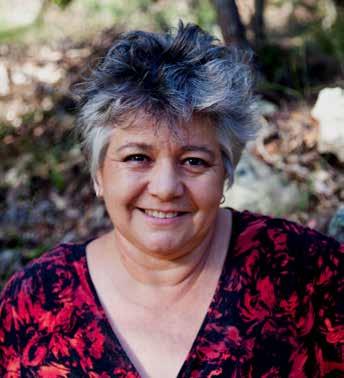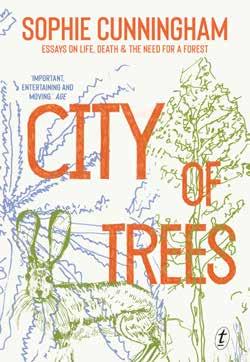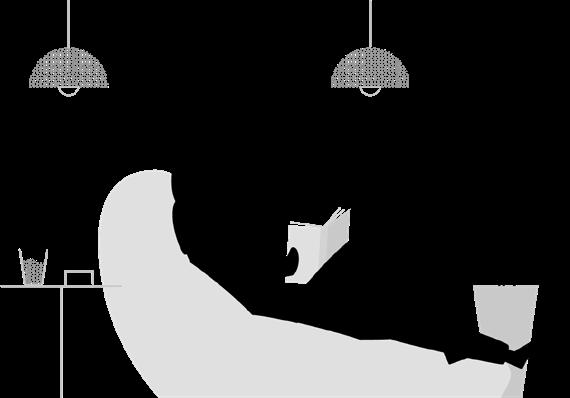
10 minute read
Portrait of the artist
Lip service: A meeting with Melissa Lucashenko
Melissa Lucashenko enjoyed a stellar 2019 on the back of her latest novel, Too Much Lip. Here, local writer Rebecca Ryall reflects on a profound recent meeting with the author.
Advertisement
I meet with Melissa Lucashenko on a spring afternoon in the plaza at Southern Cross University’s (SCU) Lismore campus. It’s late afternoon and the plaza is nearly deserted, which is perfect for me. It’s not our first meeting – I attended a workshop she facilitated for writing students at SCU a few days earlier. And I had glimpsed her at Byron Writers Festival the month before. On that occasion, she had impressed me for the most mundane of reasons. When she took her seat in the audience (of a panel discussion involving women writers of colour) I was a little in awe of the literary legend in front, until, that is, I saw she was wearing tracksuit pants. Mundane, yes, but symbolic, in my view, of someone very down-to-earth and lacking pretence. This interview is for a student publication, but we also discuss my research interests, which include connection to Country. She recommends the work of Tasmanian Indigenous artist Julie Gough. Examining Julie’s work, I see more clearly what Melissa is doing with her writing. Like Gough, Melissa explores alternative narratives, re-centring the Indigenous experience and giving it back. She tells me that she writes her novels with multiple layers. ‘I aim to write books that any reasonably literate person can read and enjoy; at the same time, I aim to write literary fiction,’ she says. ‘Too Much Lip can be read just as an adventurous yarn; reading it from a literary perspective reveals the subtext and reading as a blackfella reveals a whole other set of subtexts.’ This has been my observation of her work. In an early
scene in the book, local Bundjalung elders are called upon to conduct a ceremonial smoking by a young (non-Indigenous) couple, being kept awake by an (apparent) disgruntled former Indigenous custodian. The obliging Uncles arrive, conduct a suitably solemn and baffling ceremony before departing, chuckling over the gullible whitefellas, insomniac due to the termites slowly consuming the house around them. As a whitefella engaging with Indigenous ontology, I return to this scene regularly, lying wakeful in my own termiteridden house in the sticks. Melissa is planning her own move to the bush soon, but has much to say besides, about connection to Country being just as important in the built environment as the ‘wild’. ‘Everything has a Dreaming and the built environment tells its own story, of who made it, who uses it,’ she tells me. I am reminded that the paving stones under my feet are part of the landscape that is Country, as much a historical text as a Reynolds. Melissa was born and raised in Logan, south of Brisbane, and it is to Brisbane she returns for her current work. She expects she will spend the next three years or more of her life immersed in the chaotic world of colonial Brisbane. This is her PhD thesis, and the scholarship she was awarded to complete it will allow her to fully focus on the work, as well as plan her upcoming move back to Bundjalung Country in northern NSW. Her first foray into fiction was driven by boredom with her public policy thesis, but also the lack of Indigenous
representation in literature. ‘There were hardly any Indigenous writers getting published back then. There was a big, gaping void. I was twenty-five and full of piss and vinegar and I thought the world needed to hear what I had to say.’ She laughs self-deprecatingly but was clearly right. Melissa is quoted as saying that she ‘wanted to write about the grassroots mob who are constantly living on the edge of things: the law, racist violence, various kinds of family implosions.’ With Too Much Lip, she has done so, with characters so authentically drawn that readers can find themselves reflected there. It is storytelling that builds empathy, so perhaps this book can be seen as an extension of Melissa’s other great passion – social justice organisation Sisters Inside. Alongside Deb Kilroy (now an OAM bearer, but then a recently released prisoner), Melissa was one of the co-founders of Sisters Inside (in 1992). The organisation works alongside girls and women, supporting and advocating on their behalf within governments and the legal system, to achieve fairer outcomes for some of the most marginalised individuals in society. In telling stories which directly address the lived experience of Indigenous people in contemporary Australia, Melissa affords the non-Indigenous reader a greater level of understanding, whilst empowering her mob by giving them and their stories mainstream representation. The Indigenous characters Melissa writes are strong and proud. She tells me that she made a conscious decision early on that all her Indigenous characters had to have four things. ‘Humour, beauty, power and land. And since Mullumbimby I have added another must-have to the list – love.’ Melissa maintains that the people and situations she writes are not based on real life, rather they are imagined, possessing elements from multiple people in her life. The real beauty of her characters is their complexity, their flaws. The relationships and interactions explored in Melissa’s novels are notable for their authenticity – you can imagine yourself having a conversation like that, or falling for a guy like that, or feeling that way. I live in the hills on Bundjalung Country. Versions of the stories Melissa sets in these hills really happen in these hills; the character portraits she paints could really exist here. The real gift of Melissa’s writing is that her language is the accessibility of her language. She wants people to read her novels and connect with the stories so she writes in a universal way, with the odd Goori language word thrown in. Doing so means she can connect with a diverse audience – not just the whitefella academics. And this, ultimately, is the reason her books are so highly acclaimed.
Beneath the canopy

Review by Jenny Bird
A tree is never just a tree. It speaks of the history of the place where it has grown or been planted: the hills that were dynamited, the creeks that were concreted, the water that has been drained to give it a place to root. Trees speak of the displacement of first nations. Of the endless wanderlust of governments (small and large) to control places and the ways in which trees should or should not grow, the ways in which humans should or should not live. — City of Trees
A tree is never just a tree A lot can happen in the space of a year. During the twelve months since Sophie Cunningham’s City of Trees: Essays on Life, Death and the Need for a Forest was launched by Text Publishing, millions of hectares of forests burned in South America, California and Australia, incinerating billions of animals and emitting millions of tonnes of carbon dioxide into the atmosphere. The climate crisis rushed in from a hypothetical future and stamped itself on this very real present. I read City of Trees through this last summer of fires across Australia. At times I found it unbearable and had to put it down. Sentences that I knew Cunningham had written before the fires broke my heart: ‘The production of your average physical book takes months, which is plenty of time for an entire ecosystem to be destroyed.’ Or this: ‘less than ten percent of Australia’s presettlement forests remain.’ Text’s publicity notes from
April 2019 state that the book forms ‘part of a timely – and urgent – conversation on Australia’s relationship with its natural environment.’ Little did they know that events that lay just ahead would amplify the urgency to a howl. Yet I also found this collection of deeply considered love letters to trees, nature and our damaged planet fortifying and soothing. Cunningham’s writing invites a warmth and intimacy with her readers, like having a long lunch with a well-informed friend where the conversation meanders and ranges wide. By threading memoir through the collection, we meet Sophie, her wife, her two fathers and her walking friends. She shares her writing process, her travels, and her love for walking and for trees. I developed an affection for Sophie Cunningham and worried terribly about her during the summer of fires. Cunningham knows and loves trees not just as botanical species, but in their relationship to humans. Like William Blake, Walt Whitman and Henry David Thoreau before her, she is alert to the wisdom of trees. She is not afraid to assert that trees ‘are, in a way, sentient,’ and that anthropomorphising trees is useful in progressing their cause. Her essays are like canopies in a forest – light, lacy, spacious, separate but connecting, overlapping. She is interested in both the patterns and randomness of things. In the hands of a less assured writer, a discursive style like Cunningham’s risks losing readers in a labyrinth of facts and stories. She asks her readers to trust her divergences, to stay with her, as she makes
broad points out of rigorously researched threads of disparate things. Clues to Cunningham’s determination to avoid linearity in her essays can be found in her reflections on walking and writing. Cunningham is a committed walker and employs walking as a device to explore some topics. She quotes Rebecca Solnit in Wanderlust: A History of Walking: ‘As a literary structure, the recounted walk encourages digression and association.’ Near the end of the book, Cunningham reflects on the notion of narrative fallacy, the tendency to try
to neaten things with hindsight, or to create a logical discourse through the inclusion of incidental details that are not, in fact, related … I do not want to give in to the siren song of a resolved narrative. One that makes sense of what humans are doing to this planet… Confronted with the unavoidable truth of the summer of fires, I found myself drawn to the heading of one of Cunningham’s essays: ‘Staying with the Trouble’. I followed up on the reference to American feminist theorist Donna Haraway, who published a book with that title in 2016. Haraway outlines a new ethics for ‘living and dying together on a damaged earth’ as a means towards building liveable futures. Staying with the trouble feels like a mindset, a scaffold, that I can sign up to, and I’m grateful to Cunningham for introducing it. Since reading City of Trees, I am all ears and eyes to tree stories in the press, but in a new Cunningham kind of way. I am inquisitive, for example, about the very different fates of two ancient species of tree endangered by the bushfires in New South Wales. Why did a Wollemi pine forest hidden deep in a gully in the Blue Mountains, west of Sydney, deserve a secret, military-style rescue operation carried out by expert fire fighters, whilst the last 100 or so ancient Gondwanaera nightcap oaks in the Nightcap National Park in the north of the state attract no rescue effort at all and have been left devasted by fire? Does history privilege trees unevenly in the same way that it does humans? As politicians and governments begin to formulate their response to the Australian fires, I realise that both the burned and the remaining untouched forests are vulnerable to more clearing, more logging, as if getting rid of trees is the answer to getting rid of fires and avoiding the root cause of the climate crisis. Again, I am drawn to the heading of one of Cunningham’s essays: ‘I Don’t Blame the Trees’. Cunningham is in America and interviews a man called Peter who lost his mother in the 1991 Oakland, California firestorm that claimed twenty-five lives. He says, ‘I want to make it clear that I don’t blame the trees.’ Stay with the trouble. Don’t blame the trees.
Text Publishing / 224pp / $19.99









